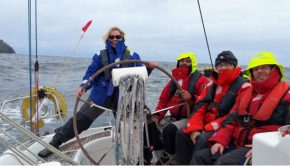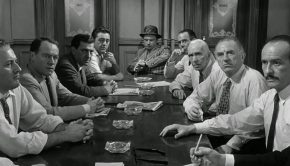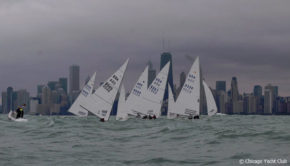The Tale of Three Fleets – Sustaining the Fleet for the Long Run
Published on May 23rd, 2013
By Glenn McCarthy
The latest and hottest boat with huge sales just hit town. The underlying question is, “What will be its longevity?” Fiberglass boats last forever, pretty much. Will this be additional boats on the starting line, or will this just replace the older fleets causing those boats to disburse? How do you keep the older fleets going when a few have jumped over to the new hot boat fleet?
South Sound Sailing Society, Olympia, Washington
Bill Brosius wanted a Star Fleet and knew the demographics of the area, and knew what people were willing to spend on buying a boat and maintaining them annually. So, he started out in 2001 by setting up some rules for his Star Fleet. The first rule was that only boats built before 1980 could join the fleet (this was the year that epoxy resin was first used in boat builds), sails when purchased must be used and at least 1 year old, all boats are wet-moored, and all bottoms must use the same bottom paint and be applied by the same person. Any boat not being used in a race is to be made available for newcomers to come out and try the boat.
To show how even things are, nine of the boats in the fleet are wood, and the rest fiberglass. Star Class rules limit sail materials to Dacron. They even have Star #927, built in 1927, sailing. They sail only on Thursday nights, with races 45 minutes to 1 hour long, and they decide how many to race each evening based on wind conditions. All boats are hauled for the winter.
To build the fleet, Brosius criss-crossed the western part of the country looking for decent old Star boats. He’d buy them and take them to a pole barn he built on his property to work on them. He has re-cored hulls and decks on fiberglass boats and re-planked-including new keelsons-wood boats. He would do whatever work was necessary to make them sailable, and would then get them in the hands of an interested party for only what he paid for the boat and what parts cost him. He doesn’t charge for his labor. One boat wanted to go retro, so he scoured the country for a wooden mast and found one. He paints the bottoms of all of the boats in the fleet.
With 26 boats in the fleet, and taking children into the fleet to sail, they have become known for fleet growth. In a harbor not too far away from Olympia, a group is gathering in 2013 wanting to mimic South Sound Sailing Society’s success.
Tartan Ten, Chicago, Illinois
Right in their first rule, this Class declares “low cost of ownership” as their goal. They limit sail purchases to two per year and limit the number of professional sailors onboard. Main sails must be made of Dacron, spinnakers of Nylon, and jibs of either Dacron or Mylar. With boats first being built in 1978, they continue to dominate the numbers of boats on starting lines and have the biggest fleet of boats in the region.
Some boats have done complete rigging overhauls and core replacements. The LS-10 (updated version of the Tartan Ten) came to being to help perpetuate the Class by putting some modern updates, including a hard doghouse rather than the canvas doghouse. The LS-10 went through a plethora of tests before the Tartan Ten Fleet accepted them as “one-design” and this has worked out well. With the arms race well contained, one can spend as much or as little as they want and be close to even equipment-wise at the end of the day. Today the Fleet puts on a number of seminars and socials to keep the fun factor high.
Ensigns, Menominee, MI
My good friend Mike Derusha wanted a fleet of Ensigns sailing at his club, the Marinette & Menominee Yacht Club, in 1992. He bought one, fixed it up and started taking others out for a sail, convincing them they should own one, too. It worked. Mike began a search for Ensigns – finding them in barns, fields and just about anywhere he could, by networking like mad. He would drive out and drag these boats back to his club, sometimes having to put new tires on the trailers, before hauling them.
Mike helped with the sweat equity. The boats would be put back into sailing condition and the fleet grew so well that in 1998 they held the Ensign National Championship. Regularly, they would have 13-14 boats out on the starting line. A few years later, the fleet diminished.
What happened? It appears that the arms race had no containment. Some boats were wet moored, others dry moored. With those in the water, some had their bottoms washed regularly, others not so often. Some were buying new sails regularly, others not so often. Some had their boats sent to professional refinishers who faired and long-boarded the boats to a mirror finish, others were satisfied as-is. The performance on the race course quickly found those who were not investing as much money into their boats became outgunned and they lost interest quickly.
Conclusion
These fleets also used the Class scantlings and Class measurement rules to keep things even. These stories are all about containing the Arms War, keeping it affordable for everyone in the fleet. It gives those with lesser fortunes the opportunity to keep up with those with greater fortunes.
What can be learned from this?
1. It takes catalyst; it takes a Bill Brousis, Mike Derusha and the fun factor like the Tartan Tens taking the time in their lives to bring a fleet to success.
2. It takes putting cost containment rules in place from the outset.
3. While not described in the article, it takes social events and those catalysts to continue to bring new people out sailing on their Class boats.
4. Sell, sell, sell!
Source: http://www.lmsrf.org/lmsrf/images/stories/newsletters/2013_05_LMSuRF.pdf







 We’ll keep your information safe.
We’ll keep your information safe.